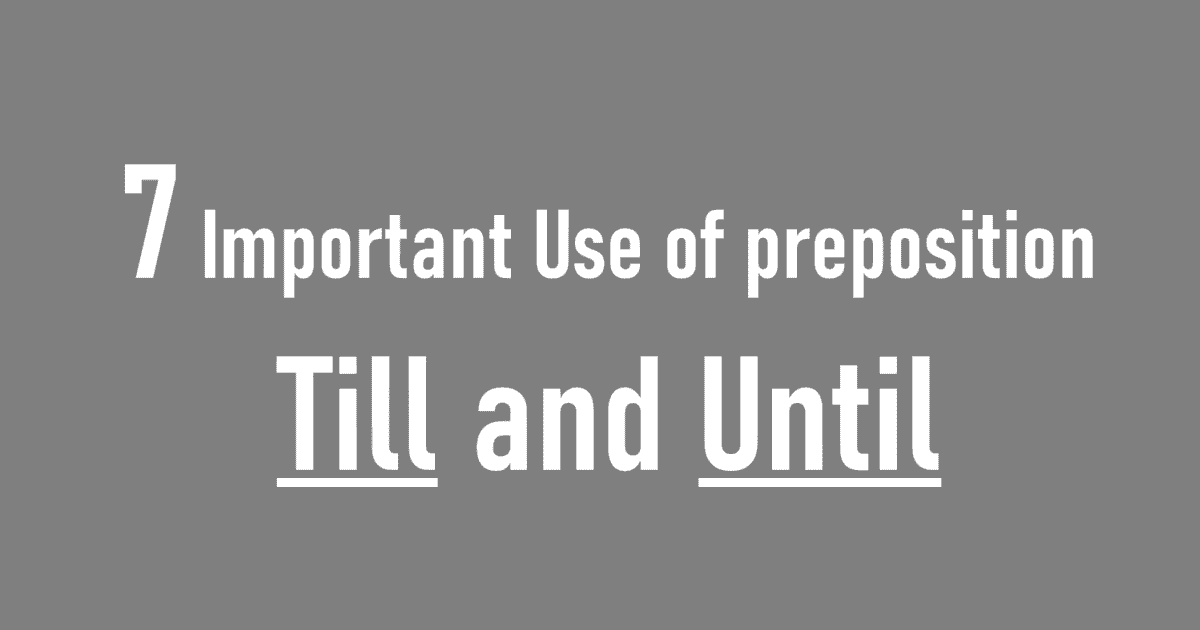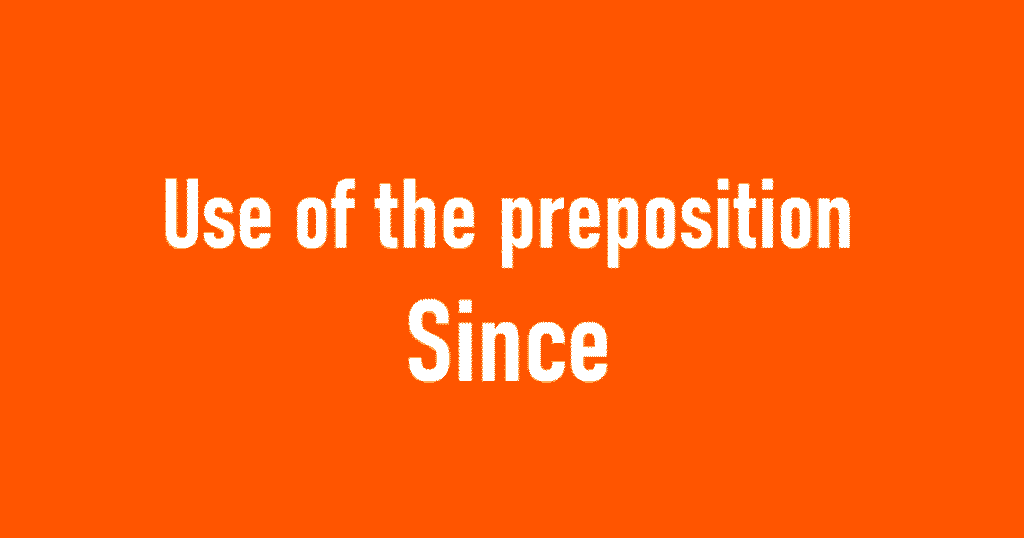Use of preposition Till and Until. “Till” and “Until” – two little words that pack a punch when it comes to defining time. They’re so common in everyday language, yet often confused or used interchangeably, leading to subtle shifts in meaning and even grammatical errors. This post will delve deep into the nuances of these temporal prepositions, exploring their meanings, proper usage, subtle differences, and common pitfalls. By the end, you’ll be equipped to use “till” and “until” with confidence and precision.
Use of preposition Till and Until
Understanding the Core Meaning: Defining a Time Limit
At their core, both “till” and “until” function as prepositions that define a point in time, marking the end of a duration. They essentially indicate up to a specific moment. Think of it as drawing a line on a timeline – “till” and “until” tell you when the line ends, the point at which something ceases or a condition no longer applies.
Here are some fundamental examples:
- “I’ll wait till 5 PM.” (I will wait up to 5 PM, and no longer.)
- “The store is open until midnight.” (The store remains open up to midnight, and then closes.)
- “We stayed at the party till everyone left.” (We remained at the party up to the point when everyone left.)
- “The subscription is valid until next month.” (The subscription remains valid up to the end of next month.)
In each case, these prepositions specify the duration of an action or state by setting a clear endpoint. The event or state continues up to but not beyond the specified time.
“Till” vs. “Until”: A Deep Dive into the Distinctions
While often used interchangeably in informal settings, there are some subtle distinctions between “till” and “until” worth understanding:
- Formality: “Until” is generally considered more formal than “till.” This makes “until” the preferred choice in formal writing, academic papers, business correspondence, and situations where precision and clarity are paramount. “Till,” on the other hand, is perfectly acceptable in everyday conversations, informal emails, and less formal writing.
- Origin and Etymology: “Till” is actually a shorter, variant form of “until.” The word “until” itself is a combination of “un-” (meaning “up to” or “as far as”) and “till.” This explains their semantic overlap.
- ” ‘Til ” vs. “Till”: It’s important to note the existence of “’til.” This is a contraction of “until,” similar to contractions like “don’t” for “do not.” While grammatically correct, “’til” is generally considered less formal than “till” and “until” and should be used sparingly, primarily in informal contexts where a more relaxed tone is desired. Using “til” without the apostrophe is generally considered incorrect and should be avoided.
- Starting a Sentence: While not strictly grammatically incorrect, starting a sentence with “till” can sometimes sound less polished and more informal than starting with “until.” In formal writing, opting for “until” at the beginning of a sentence can enhance its clarity and sophistication.
- Less Formal: “Till the cows come home, I’ll keep practicing.”
- More Formal: “Until the cows come home, I will continue practicing.”
Correctly Positioning “Till” and “Until” in Sentences
The placement of “till” and “until” within a sentence is crucial for conveying the intended meaning. They typically precede a noun, a pronoun, or a clause that specifies the endpoint of the action or state. Here are some common sentence structures:
- “Till/Until + Noun/Pronoun/Noun Phrase”: This is the most straightforward construction.
- “Wait till tomorrow.” (Tomorrow is a noun.)
- “Stay here until he arrives.” (He is a pronoun.)
- “They will work till the end of the week.” (The end of the week is a noun phrase.)
- “Till/Until + Clause”: The clause specifies the condition or event that marks the endpoint.
- “I won’t leave until I finish my work.” (The clause “I finish my work” specifies the endpoint.)
- “We’ll keep trying till we succeed.” (The clause “we succeed” marks the termination point of the effort.)
- “He practiced the piano until his fingers were sore.” (The clause “his fingers were sore” indicates the duration.)
Common Mistakes and How to Avoid Them
Despite their apparent simplicity, “till” and “until” can be misused, leading to grammatical errors and ambiguity. Here are some common pitfalls to watch out for:
- Redundancy: “Until When?” Avoid phrases like “until when?” or “till when?” The “until” or “till” already implies the question “up to what point?” Adding “when” is redundant and grammatically awkward. Instead, simply ask, “When?”
- Confusing “Till/Until” with “By”: While both “till/until” and “by” deal with time, they have different meanings. “Till/Until” indicates a duration up to a point, while “by” indicates a deadline – at or before a certain point.
- “Submit your application till Friday.” (Incorrect – suggests you can submit all day Friday)
- “Submit your application until Friday.” (Incorrect – suggests you can submit all day Friday)
- “Submit your application by Friday.” (Correct – implies the deadline is Friday, and it should be submitted on or before that day.)
- Double Negatives: Be careful not to use “till” or “until” in a sentence that already contains a negative word. This can create a double negative, which can be confusing and often implies the opposite of what is intended.
- “I won’t leave until I don’t have any work.” (Incorrect – this effectively means “I will leave when I have work.”)
- “I won’t leave until I have finished all my work.” (Correct)
- “I won’t leave till I finish all my work.” (Correct)
- Misspelling: “Til” (Without Apostrophe): As mentioned before, “til” without the apostrophe is generally considered a misspelling. Always use “till,” “’til,” or “until” depending on the desired level of formality.
- Using “Till” at the Beginning of a Formal Sentence: While grammatically acceptable, using “until” at the start of a formal sentence generally sounds more polished and professional.
“Till” and “Until” in Different Contexts
The specific meaning and impact of “till” and “until” can vary depending on the context. Here are a few examples:
- Legal and Contractual Agreements: In legal documents, using “until” is almost always preferred due to its formality and precision. A clause like “This agreement is valid until December 31, 2024” leaves no room for ambiguity about the expiration date.
- Instructions and Directions: When giving instructions, both “till” and “until” can be used, but clarity is key. For example, “Mix the ingredients until smooth” clearly indicates the endpoint of the mixing process.
- Narrative Writing: In storytelling, the choice between “till” and “until” can contribute to the overall tone. Using “till” might create a more casual and conversational feel, while “until” can lend a more formal or serious tone.
Key Takeaways: Mastering “Till” and “Until”
To summarize, here are the key takeaways to help you master the use of “till” and “until”:
- Both “till” and “until” indicate a time limit or endpoint.
- “Until” is generally considered more formal than “till.”
- “‘Til” is a contraction of “until” and is less formal than both “till” and “until.”
- Avoid phrases like “until when?” – they are redundant.
- Distinguish between “till/until” (duration up to a point) and “by” (deadline).
- Be mindful of double negatives when using “till” or “until.”
- Avoid using “til” without an apostrophe.
- In formal writing, prefer “until” at the beginning of a sentence.
By understanding these nuances and common pitfalls, you can confidently use “till” and “until” in a wide range of contexts, ensuring clarity, precision, and the appropriate level of formality in your writing and speech. So go forth and wield these temporal prepositions with mastery!
Read Also,
- Learn all prepositions
- Use of the preposition above
- Use of the preposition about
- What is Religion
- News in Hindi
- Human vs AI
- Very Important Word Lists
>>> Sir Sahil

